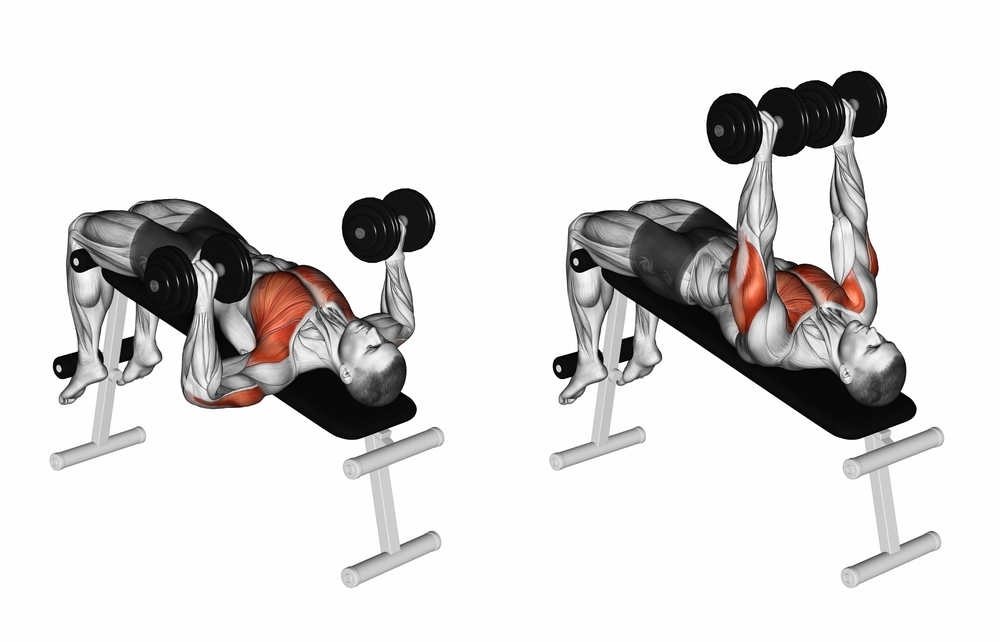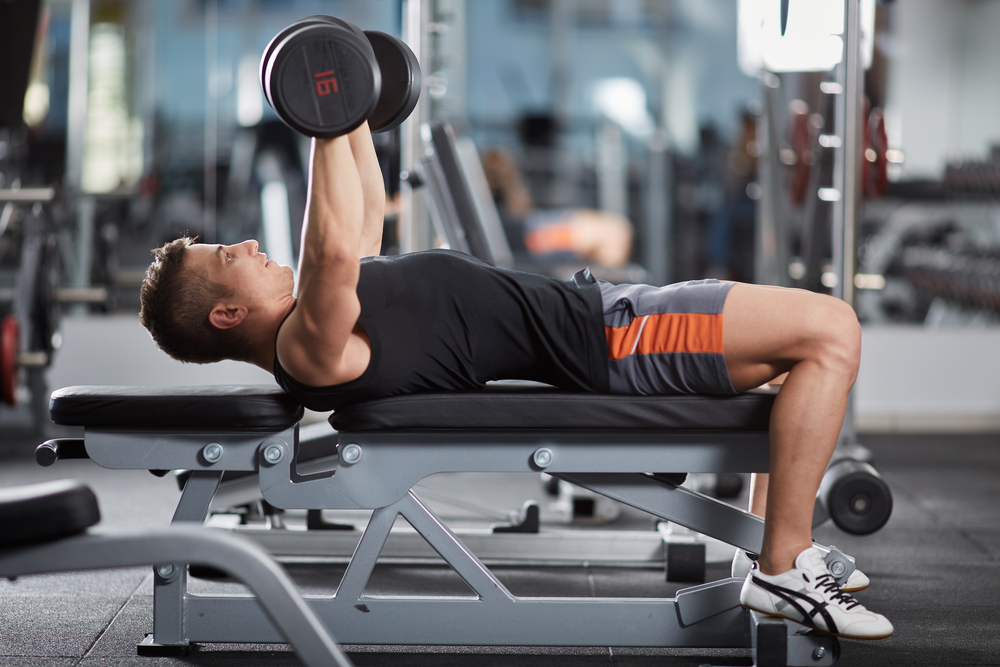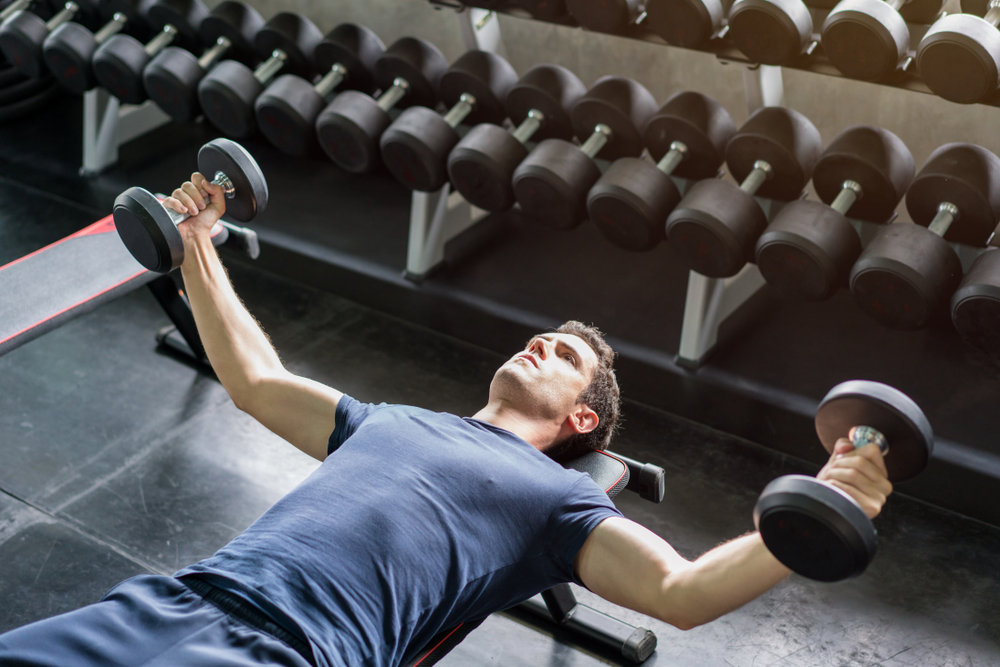The benefits of the bench press are well-understood, but what about the decline bench press? Gym regulars may work in an occasional set of bench presses at a decline. Many, however, look on with confusion and fear. Why would you need to lie so dramatically far back? Is it safe? What benefit could it possibly have?
The decline bench press is one of the most effective chest-building exercises. Like the regular bench press, it targets the major muscles in your chest as well as your triceps. Due to the unique angle, the decline bench press targets your lower pectoralis major muscle, all while putting the least amount of stress on your lower back and shoulders.
The benefits are innumerable, but you’ll have to overcome the intimidation factor to get started. Read on and we’ll have you working in declines in no time!
Contents
- What is Decline Bench Press Good For?
- Do You Really Need to Do Decline Bench Press?
- Are You Stronger on Decline Bench?
- Benefits of Decline Bench Press
- Is Decline Bench Better than Flat?
- Decline Bench Press Muscles Worked
- How to Set Up a Decline Bench Press
- Tips for Decline Bench Press
- Drawbacks of Decline Bench Press
- Decline Bench Press Dumbbell
- Benefits of Decline Dumbbell Press
- Decline Bench Press Alternatives
What is Decline Bench Press Good For?
The decline bench press targets your lower pecs better than the flat and incline bench alternatives.
Due to the angle you create by laying at a decline, your lower pecs work harder. That’s not to say you can’t still get a great lower chest workout using a regular bench press. However, it’s best to alternate between, flat, incline, and decline to work the chest at all angles.
In addition to the lower chest, decline bench works out your:
- Triceps brachii in the back side of your upper arm
- Biceps brachii on the front side of your upper arm
- Anterior deltoid in the front of your shoulder
Like a regular bench press, a decline bench press works the arms both when lowering the weight and pushing it back up.
Also, because of the decline angle, the movement tends to be gentler on our back and shoulders.
Do You Really Need to Do Decline Bench Press?
Incorporating decline bench presses into your routine may or may not be beneficial depending on your goals.
For bodybuilders looking to carefully sculpt and balance their physique, it is essential to do decline bench press. Working in the decline bench press routinely is one of the best ways to target the lower chest. If you are exceptionally lean and mostly interested in visual benefits, the decline bench press is a must.
For athletes focused more on performance, it’s still prudent to cultivate a strong chest. However, you’ll still get great results sticking to regular bench presses or even push-ups.
For average gym goers who are most interested in staying healthy or losing weight, the decline bench press may not be necessary. In fact, some casual gym goers may not need to bench at all to stay in good shape.
The decline bench press, however, is gentler on the shoulders and back. This makes it an ideal way to get in a chest workout if your back is sore from the day before.
Are You Stronger on Decline Bench?
The decline bench press is essentially the same movement as the flat bench, just at an angle. So, it would stand to reason that we’d lift roughly the same on decline as we could on a regular bench, right?
Wrong.
One study observed that participants were capable of lifting 125% of their body weight at a decline, yet only 107% at an incline.
That means your decline bench press might be almost 25% heavier than your other bench press numbers! That’s a big difference, and there’s a reason why.
The decline position takes stress off weaker muscle groups like the shoulders. This lets the stronger muscle group, the chest, bear the brunt of the weight.
It may feel harder since you’re at a weird angle, but most people should put up bigger numbers on the decline bench press.
Benefits of Decline Bench Press
The decline bench press has many benefits.
1) It targets the lower pecs
This is the number one reason why people bother benching at a decline in the first place.
You’ll get great chest activation during the regular or incline bench press. However, once you tip that bench back 15 to 30 degrees, you hit the chest even harder. Because of the angle, you also hit it low at the bottom of the pec.
2) It hits the triceps
Most chest exercises involve pushing, so you’ll often get a solid triceps workout in the process. The decline bench press is no exception to the rule.
Dedicated bench press lovers can feel free to swap the standard bench for decline without worry. You’ll still hit the triceps, building strong and more well-sculpted arms.
3) It puts the least amount of stress on the lower back
The decline position is a saving grace for those working through back injuries. Of the three variations of bench press, decline is the least stressful on the back.
When benching on a flat bench or at an incline, we often arch our backs to generate more power. Even minimal arching can cause pain or soreness to the lower back. However, the decline bench occurs at a lowered angle, eliminating the need for an arch.
The result? More pain-free backs, and that’s never a bad thing.
4) It puts less stress on the shoulders
Your back isn’t the only part getting some relief. Your shoulders should also reap some reward due to the shorter range of motion and increased activation of the lower pec.
The change in bar path plays a factor as well.
All in all, using the decline variation will help your back and shoulders get rest while hitting your chest hard. Win-win!
5) It allows you to lift heavier
All the aforementioned benefits contribute to one very pronounced benefit.
You will be able to bench heavier weight.
Or at least you should. Studies show that you should be able to push a little bit heavier than you would while flat or at an incline. The increased weight will help you get stronger and fitter faster.
What’s not to love about that?
Is Decline Bench Better than Flat?
The decline bench press is an underutilized and useful lift for comprehensive chest-building. However, it’s not the best of the three variations.
The standard flat bench is the best option for overall chest hypertrophy.
You will activate the entire chest region during the flat bench, rapidly building strength and mass. That’s one of the reasons most gym regulars prioritize this essential chest-building lift first and foremost.
The regular bench is also a more attractive option, especially to more casual lifters. Lying flat on your back is intuitive. We do it every day. Adding a barbell to lower and push back up, therefore, is not overly complicated.
Add a slight decline to the lift, and suddenly people are confused. Many are concerned that they may slip right off the bench and onto the floor, getting injured in the process. Of course, the decline bench is not overly complicated, but it is often intimidating at first.
For this reason, the standard bench press is also more accessible than the decline variation.
Decline Bench Press Muscles Worked
The decline bench press works out your chest and your arms.
More specifically, the decline bench press works out the following:
- Sternal head of your pectoralis major
- Triceps brachii in the back side of your upper arm
- Biceps brachii on the front side of your upper arm
- Anterior deltoid in the front of your shoulder
Let’s break it down. When you remove the weight from the rack and hold it in the starting position, you need to stabilize it. You may feel this in both the chest and the arms. On the descent, your anterior deltoid and lower pec contract, along with the bicep brachii to a lesser extent.
Once the bar touches down, you push it back up. This forces the triceps brachii to contract and gives a great burn to the backs of your arm. Your lower pecs also work while extending the arm, tightening fully at the top of the position.
Start to finish, the decline bench press is an absolute chest and arm torcher.
How to Set Up a Decline Bench Press
One of the main reasons people keep away from decline bench presses is the intimidation factor. Let’s be real here– it looks like you’re going to slide off the bench and get hurt. We’ve all been there, and we promise you you’ll be just fine.
Just make sure you set up your decline bench press properly using the following steps:
- Set bench to decline– Some benches in the gym are pre-set and forever in a decline position. If no such bench is at your gym, lower the bench so it is between 15 and 30 degrees of decline. Once your bench is set, you can rack the barbell and the weight.
- Lock feet in beneath foot roller pads– Remember that fear we talked about? If you fail to lock yourself in here, then sliding off the bench is a real possibility. Slip your legs and feet beneath the rollers and make sure you’re nice and secure before proceeding.
- Assume the position– You’re locked in, and the weight is waiting. Now it’s time to get into position. Your eyes should be directly beneath the bar. Your grip should be slightly wider than the width of your shoulders. You want to maintain a neutral spine and neck. Tuck your chin. Tighten your core. Grab the bar.
- Remove from the rack and get in your reps!
It’s as simple as that. Your positioning is altered slightly considering the angle, but it otherwise plays out similarly to the standard bench press.
Tips for Decline Bench Press
If you’re a bench press aficionado, most of the classic wisdom applies to the decline bench press as well.
- Keep the weight manageable– Of course, you want to go heavy on your heavy sets and when testing your 1RM. For most working sets, the weight should always be something you can handle with good form. Never, never push past your limits if it’s at the expense of good form!
- Don’t bounce the weight off your chest– You might feel real cool racking up loads of weight and blasting it up and down with great speed. In reality, you’re shortchanging yourself. Bouncing the weight off your chest feels easy because it is easy. Plus, you might hit too hard and cause injury. Instead, control the motion on the descent, pause at the bottom briefly, and push it back up explosively. Maintaining control from start to finish will give you the best benefits from the movement.
- Keep the bar path straight– Just like with most lifts, keeping the bar path straight is crucial. Wobbling around might indicate you’ve gone too heavy. In addition, you might just wobble past a joint’s natural range and accidentally injure yourself. Focus on the bar path for each rep and make sure it stays straight.
Drawbacks of Decline Bench Press
The main drawback of the decline bench press is the one that keeps most people from trying it in the first place.
It looks scary.
Casual gym goers may already feel daunted by holding a barbell over their faces from a lying position. Tilt the flat bench to a decline and that fear intensifies. We worry that we’ll slip and slide off the bench, taking the heavy bar with us and getting pinned by it.
As long as you lock in those feet and lift weight that is manageable, there’s no need to worry. It might feel awkward at first, but you are in no danger.
We recommend bringing a buddy to spot you in the beginning. Knowing a friend is nearby will help mitigate the fear and get you comfortable with this slightly unnatural movement.
Decline Bench Press Dumbbell
Usually, we see folks default to the barbell when bench pressing, whether it’s incline, decline, or regular.
But what about dumbbells? Can we swap the bar for two heavy dumbbells instead?
Yes, you can absolutely use dumbbells for the decline bench press.
Like subbing dumbbells for the regular bench, you’ll need to use more stability muscles to keep them from wobbling wildly. This makes the lift harder, but also provides more benefit. Each rep involves more muscles and provides an even more comprehensive workout.
Benefits of Decline Dumbbell Press
Using dumbbells to decline bench press is a better workout than using a barbell.
The effort required to hold each individual dumbbell without wobbling is surprising. This means you likely won’t be able to lift quite as heavy until you adjust.
Don’t let your ego get the best of you here and scale appropriately. Good form is always better than more weight, so it’s prudent to lift lighter until you acclimate. Once you’re used to stabilizing each individual dumbbell, you will be able to go heavier.
And once you do, you’ll make gains even faster.
Another benefit is that you can do it anywhere there’s a bench.
The bench press stations are prime real estate at the gym. You need impeccable timing to snag one before the next bench presser gets cozy and hunkers down. By choosing dumbbells instead of a barbell, all you need is a bench that tilts back and you’re golden.
Decline Bench Press Alternatives
There are a number of decline bench press alternatives that you can add to your regimen, including:
- Decline dumbbell bench press
- Decline dumbbell together press
- Decline dumbbell chest flyes
However, all of these alternatives still require you to grab a decline bench and get to work. If you’re looking for something that takes the decline bench out completely, try:
- High to low cable fly
- Forward-leaning dips
- Incline push-ups with underhand grip
These movements target the lower pec in similar fashion while removing the need to lie way back.
You may sub in standard bench press or chest exercises as well. Keep in mind, you will target the lower pecs less using regular chest movements. However, you will still hit the whole area and get great gains regardless.





